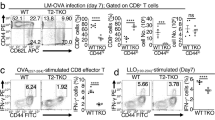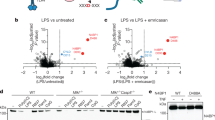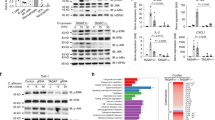Abstract
The mechanism by which mutations in CARD15, which encodes nucleotide-binding oligomerization domain 2 (NOD2), cause Crohn disease is poorly understood. Because signaling via mutated NOD2 proteins leads to defective activation of the transcription factor NF-κB, one proposal is that mutations cause deficient NF-κB-dependent T helper type 1 (TH1) responses and increased susceptibility to infection. However, this idea is inconsistent with the increased TH1 responses characteristic of Crohn disease. Here we used Card15−/− mice to show that intact NOD2 signaling inhibited Toll-like receptor 2–driven activation of NF-κB, particularly of the NF-κB subunit c-Rel. Moreover, NOD2 deficiency or the presence of a Crohn disease–like Card15 mutation increased Toll-like receptor 2–mediated activation of NF-κB–c-Rel, and TH1 responses were enhanced. Thus, CARD15 mutations may lead to disease by causing excessive TH1 responses.
This is a preview of subscription content, access via your institution
Access options
Subscribe to this journal
Receive 12 print issues and online access
$209.00 per year
only $17.42 per issue
Buy this article
- Purchase on Springer Link
- Instant access to full article PDF
Prices may be subject to local taxes which are calculated during checkout








Similar content being viewed by others
References
Ogura, Y. et al. A frameshift mutation in NOD2 associated with susceptibility to Crohn's disease. Nature 411, 603–606 (2001).
Hugot, J.P. et al. Association of NOD2 leucine-rich repeat variants with susceptibility to Crohn's disease. Nature 411, 599–603 (2001).
Cuthbert, A.P. et al. The contribution of NOD2 gene mutations to the risk and site of disease in inflammatory bowel disease. Gastroenterology 122, 867–874 (2002).
Hampe, J. et al. Association between insertion mutation in NOD2 gene and Crohn's disease in German and British populations. Lancet 357, 1925–1928 (2001).
Inohara, N. & Nunez, G. NODs: intracellular proteins involved in inflammation and apoptosis. Nat. Rev. Immunol. 3, 371–382 (2003).
Chamaillard, M., Girardin, S.E., Viala, J. & Philpott, D.J. Nods, Nalps and Naip: intracellular regulators of bacterial-induced inflammation. Cell. Microbiol. 5, 581–592 (2003).
Harton, J.A., Linhoff, M.W., Zhang, J. & Ting, J.P. Cutting edge: CATERPILLER: a large family of mammalian genes containing CARD, pyrin, nucleotide-binding, and leucine-rich repeat domains. J. Immunol. 169, 4088–4093 (2002).
Gutierrez, O. et al. Induction of Nod2 in myelomonocytic and intestinal epithelial cells via nuclear factor-κB activation. J. Biol. Chem. 277, 41701–41705 (2002).
Inohara, N. et al. Host recognition of bacterial muramyl dipeptide mediated through NOD2. Implications for Crohn's disease. J. Biol. Chem. 278, 5509–5512 (2003).
Girardin, S.E. et al. Nod2 is a general sensor of peptidoglycan through muramyl dipeptide (MDP) detection. J. Biol. Chem. 278, 8869–8872 (2003).
Kobayashi, K. et al. RICK/Rip2/CARDIAK mediates signalling for receptors of the innate and adaptive immune systems. Nature 416, 194–199 (2002).
Ogura, Y. et al. Nod2, a Nod1/Apaf-1 family member that is restricted to monocytes and activates NF-κB. J. Biol. Chem. 276, 4812–4818 (2001).
Girardin, S.E. et al. Nod1 detects a unique muropeptide from gram-negative bacterial peptidoglycan. Science 300, 1584–1587 (2003).
Chamaillard, M. et al. An essential role for NOD1 in host recognition of bacterial peptidoglycan containing diaminopimelic acid. Nat. Immunol. 4, 702–707 (2003).
Akira, S., Takeda, K. & Kaisho, T. Toll-like receptors: critical proteins linking innate and acquired immunity. Nat. Immunol. 2, 675–680 (2001).
Akira, S. Toll-like receptor signaling. J. Biol. Chem. 278, 38105–38108 (2003).
Chamaillard, M. et al. Gene-environment interaction modulated by allelic heterogeneity in inflammatory diseases. Proc. Natl. Acad. Sci. USA 100, 3455–3460 (2003).
Bonen, D.K. et al. Crohn's disease-associated NOD2 variants share a signaling defect in response to lipopolysaccharide and peptidoglycan. Gastroenterology 124, 140–146 (2003).
Bouma, G. & Strober, W. The immunological and genetic basis of inflammatory bowel disease. Nat. Rev. Immunol. 3, 521–533 (2003).
Strober, W., Fuss, I.J. & Blumberg, R.S. The immunology of mucosal models of inflammation. Annu. Rev. Immunol. 20, 495–549 (2002).
Monteleone, G. et al. Interleukin 12 is expressed and actively released by Crohn's disease intestinal lamina propria mononuclear cells. Gastroenterology 112, 1169–1178 (1997).
Kanai, T. et al. Interleukin 18 is a potent proliferative factor for intestinal mucosal lymphocytes in Crohn's disease. Gastroenterology 119, 1514–1523 (2000).
Neurath, M.F. et al. The transcription factor T-bet regulates mucosal T cell activation in experimental colitis and Crohn's disease. J. Exp. Med. 195, 1129–1143 (2002).
Fuss, I.J. et al. Disparate CD4+ lamina propria (LP) lymphokine secretion profiles in inflammatory bowel disease. Crohn's disease LP cells manifest increased secretion of IFN-γ, whereas ulcerative colitis LP cells manifest increased secretion of IL-5. J. Immunol. 157, 1261–1270 (1996).
Parronchi, P. et al. Type 1 T-helper cell predominance and interleukin-12 expression in the gut of patients with Crohn's disease. Am. J. Pathol. 150, 823–832 (1997).
Pauleau, A.L. & Murray, P.J. Role of nod2 in the response of macrophages to toll-like receptor agonists. Mol. Cell. Biol. 23, 7531–7539 (2003).
Nakayama, K. et al. Involvement of IRAK-M in peptidoglycan-induced tolerance in macrophages. J.Biol. Chem. 279, 6629–6634 (2004).
Liu, J. & Beller, D.I. Distinct pathways for NF-κB regulation are associated with aberrant macrophage IL-12 production in lupus- and diabetes-prone mouse strains. J. Immunol. 170, 4489–4496 (2003).
Hilliard, B.A. et al. Critical roles of c-Rel in autoimmune inflammation and helper T cell differentiation. J. Clin. Invest. 110, 843–850 (2002).
Hisamatsu, T. et al. CARD15/NOD2 functions as an antibacterial factor in human intestinal epithelial cells. Gastroenterology 124, 993–1000 (2003).
Cario, E. et al. Lipopolysaccharide activates distinct signaling pathways in intestinal epithelial cell lines expressing Toll-like receptors. J. Immunol. 164, 966–972 (2000).
Smith, M.F. Jr. et al. Toll-like receptor (TLR) 2 and TLR5, but not TLR4, are required for Helicobacter pylori-induced NF-κB activation and chemokine expression by epithelial cells. J. Biol. Chem. 278, 32552–32560 (2003).
Fisette, P.L., Ram, S., Andersen, J.M., Guo, W. & Ingalls, R.R. The Lip lipoprotein from Neisseria gonorrhoeae stimulates cytokine release and NF-κB activation in epithelial cells in a Toll-like receptor 2-dependent manner. J. Biol. Chem. 278, 46252–46260 (2003).
Campbell, I.K., Gerondakis, S., O'Donnell, K. & Wicks, I.P. Distinct roles for the NF-κB1 (p50) and c-Rel transcription factors in inflammatory arthritis. J. Clin. Invest. 105, 1799–1806 (2000).
Sanjabi, S., Hoffmann, A., Liou, H.C., Baltimore, D. & Smale, S.T. Selective requirement for c-Rel during IL-12 P40 gene induction in macrophages. Proc. Natl. Acad. Sci. USA 97, 12705–12710 (2000).
Grumont, R. et al. c-Rel regulates interleukin 12 p70 expression in CD8+ dendritic cells by specifically inducing p35 gene transcription. J. Exp. Med. 194, 1021–1032 (2001).
Kobayashi, M. et al. Toll-like receptor-dependent production of IL-12p40 causes chronic enterocolitis in myeloid cell-specific Stat3-deficient mice. J. Clin. Invest. 111, 1297–1308 (2003).
Obermeier, F. et al. CpG motifs of bacterial DNA exacerbate colitis of dextran sulfate sodium-treated mice. Eur. J. Immunol. 32, 2084–2092 (2002).
Yang, S. et al. Synergistic effect of muramyldipeptide with lipopolysaccharide or lipoteichoic acid to induce inflammatory cytokines in human monocytic cells in culture. Infect. Immun. 69, 2045–2053 (2001).
Takada, H., Yokoyama, S. & Yang, S. Enhancement of endotoxin activity by muramyldipeptide. J. Endotoxin. Res. 8, 337–342 (2002).
Wolfert, M.A., Murray, T.F., Boons, G.J. & Moore, J.N. The origin of the synergistic effect of muramyl dipeptide with endotoxin and peptidoglycan. J. Biol. Chem. 277, 39179–39186 (2002).
Targan, S.R. et al. A short-term study of chimeric monoclonal antibody cA2 to tumor necrosis factor α for Crohn's disease. Crohn's Disease cA2 Study Group. N. Engl. J. Med. 337, 1029–1035 (1997).
Girardin, S.E., Hugot, J.P. & Sansonetti, P.J. Lessons from Nod2 studies: towards a link between Crohn's disease and bacterial sensing. Trends. Immunol. 24, 652–658 (2003).
Watanabe, T. et al. Administration of an antigen at a high dose generates regulatory CD4+ T cells expressing CD95 ligand and secreting IL-4 in the liver. J. Immunol. 168, 2188–2199 (2002).
Nishikomori, R., Ehrhardt, R.O. & Strober, W. T helper type 2 cell differentiation occurs in the presence of interleukin 12 receptor β2 chain expression and signaling. J. Exp. Med. 191, 847–858 (2000).
O'Sullivan, B.J. & Thomas, R. CD40 ligation conditions dendritic cell antigen-presenting function through sustained activation of NF-κB. J. Immunol. 168, 5491–5498 (2002).
Kitani, A. et al. Transforming growth factor (TGF)-β1-producing regulatory T cells induce Smad-mediated interleukin 10 secretion that facilitates coordinated immunoregulatory activity and amelioration of TGF-β1-mediated fibrosis. J. Exp. Med. 198, 1179–1188 (2003).
Shimamura, M. et al. HVJ-envelope vector for gene transfer into central nervous system. Biochem. Biophys. Res. Commun. 300, 464–471 (2003).
Iwanaga, Y. et al. Cloning, sequencing and expression analysis of the mouse NOD2/CARD15 gene. Inflamm. Res. 52, 272–276 (2003).
Acknowledgements
We thank J.T. Rosenbaum and M.P. Davey (Casey Eye Institute, Oregon Health and Science University) for providing us with the plasmid expressing mouse Card15; and C. Ma and S. Fichtner (Laboratory of Host Defenses, National Institute of Allergy and Infectious Diseases) for comments and technical assistance. Supported in part by the Cancer Center CORE (P30 CA21765) and the American Lebanese Associated Charities.
Author information
Authors and Affiliations
Corresponding author
Ethics declarations
Competing interests
The authors declare no competing financial interests.
Rights and permissions
About this article
Cite this article
Watanabe, T., Kitani, A., Murray, P. et al. NOD2 is a negative regulator of Toll-like receptor 2–mediated T helper type 1 responses. Nat Immunol 5, 800–808 (2004). https://doi.org/10.1038/ni1092
Received:
Accepted:
Published:
Issue Date:
DOI: https://doi.org/10.1038/ni1092
This article is cited by
-
Evaluation of serum levels of interferon beta and nucleotide binding and oligomerization domain 2 gene polymorphism in children with cough asthma phenotype: a case–control study
Egyptian Pediatric Association Gazette (2023)
-
Microbial ligand-independent regulation of lymphopoiesis by NOD1
Nature Immunology (2023)
-
NOD2 deficiency increases retrograde transport of secretory IgA complexes in Crohn’s disease
Nature Communications (2021)
-
Nod2 protects mice from inflammation and obesity-dependent liver cancer
Scientific Reports (2020)
-
Novel drug delivery systems of Chinese medicine for the treatment of inflammatory bowel disease
Chinese Medicine (2019)



